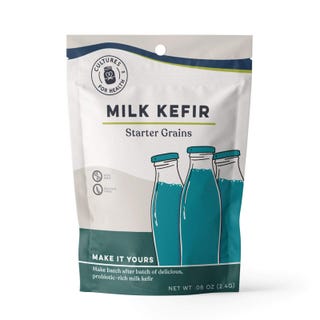AS BLUE Oyster Cult famously sang in their 1976 classic: “Don’t fear the kefir.”
Or was that “reaper?” Regardless, drinking more kefir may just help you fight the reaper.
“Kefir is a fermented dairy product made by adding kefir grains, a specific kind of symbiotic culture of bacteria and yeast, to milk,” says Kylie Sakaida, M.S., R.D., L.D.N. “Kefir has a tart flavor and a thin consistency. Kefir is a good source of protein, calcium, potassium, and probiotics which can provide a number of health benefits.”
“What many people don’t know is that many of the health benefits in kefir come from whole milk,” says Sakaida. “With 13 essential nutrients, whole milk delivers calcium, protein, vitamins D, B12, and A, zinc, riboflavin, phosphorus, and more—a combination of essential nutrients the body needs to stay naturally healthy that are hard to find in other non-dairy alternatives.”
As Sakaida points out, for someone like her who is lactose intolerant, kefir can sometimes be a solution as the process of fermentation actually reduces the lactose content while maintaining the nutrient profile. “Nowadays real dairy milk can get a bad rep but there are nutritional benefits to including it in your diet,” she says.
Kefir’s time has come.
How is kefir made?
If you enjoy tinkering around in the kitchen, homemade kefir can be a delicious and relatively straightforward project. Sakaida breaks down the instructions for making a batch of homemade kefir below.
What you’ll need:
- 1 Tbsp Kefir grains
- 4 cups whole cow’s milk
- Glass jar (around 5 cups)
- Paper coffee filters, paper towels, or a cheesecloth
- Rubber band
- Nonmetal mesh strainer
- Nonmetal spoon
- Sealable jar (around 5 cups) for final product
Instructions:
- Wash your hands and all equipment with soap and water.
- When the glass jar is dry, add ~1 Tbsp of kefir grains to 4 cups of cow’s milk.
- Cover the jar with a few paper coffee filters, paper towels, or cheesecloth and secure with a rubber band.
- Store in a warm, dark spot (65-85˚F for 24 hours). Once the liquid has thickened, pour through the mesh strainer into a sterile, sealable jar.
What is the nutrition of kefir?
Per the USDA, 1 cup of low-fat kefir provides approximately:
- Calories: 104
- Protein: 9g
- Carbohydrates: 11g
- Fat: 2g
- Calcium: 316 mg (24% of the daily value)
- Potassium: 400 mg (8% of the daily value)
- Phosphorus: 255 mg (20% of daily value)
- Vitamin B12: 0.71 µg (29% of the daily value)
- Riboflavin (B2): 0.33 mg (25% of the daily value)
- Vitamin D: 100 IU (12% of the daily value)
Is kefir good for you?
Short answer: Yes.
Longer answer: As Sakaida highlights, the vitamins and minerals in kefir largely come from the milk source while the kefir grains contain a wide variety of bioactive compounds, including organic acids and peptides that contribute to its health benefits.
What’s more, says Sakaida, if you live in America, there’s a good chance you may not be consuming enough calcium, vitamin D, and potassium. “By including kefir in your diet, you can increase your consumption of these nutrients,” she says.
Still, you don’t want to overhype its purported benefits. Sakaida cautions that although kefir can be beneficial to include in the diet, it’s difficult to link one specific food to specific health benefits in scientific studies.
“As a result, there are rarely multiple studies that fully support the conclusion that one specific food is definitively ‘good’ for you—especially since benefits can vary depending on the person,” she says. “It’s more important to focus on the overall balance of the diet and how you can include foods that you may not be getting enough of.”
With that being said, incorporating more of this nutrient-dense beverage into your diet may help you hit your daily values. The versatile ingredient can be enjoyed in a variety of ways.
Sakaida says, “Though many people drink kefir by itself, you can also add it into smoothies and breakfast cereals or use it to make creamy dressings.”
This content is created and maintained by a third party, and imported onto this page to help users provide their email addresses. You may be able to find more information about this and similar content at piano.io




Comments are closed.